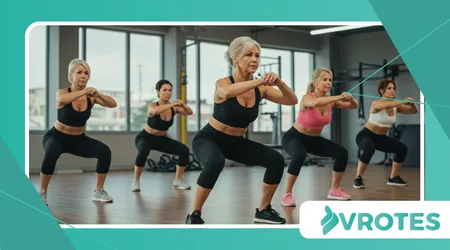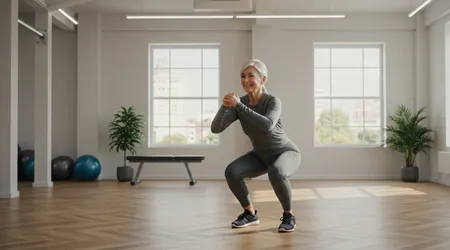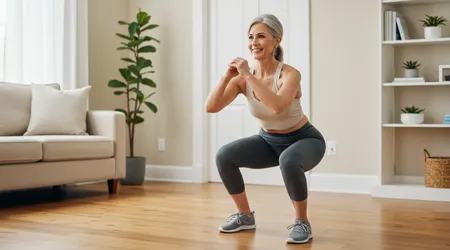Gentle Strength Training Routines to Protect Bone Density

Training routines to protect bone density are a cornerstone of health for women navigating menopause. As estrogen levels decline, bones lose density, increasing osteoporosis risk.
This isn’t just a statistic it’s a reality for millions. But here’s the empowering truth: gentle strength training can fortify your skeleton, enhance balance, and boost vitality.
Why let menopause dictate your strength when you can fight back with movement?
This article dives deep into practical, evidence-based routines tailored for midlife women, blending science with real-world application to keep your bones resilient and your spirit strong.
Menopause marks a pivotal shift, often bringing hot flashes, mood swings, and, crucially, bone health challenges.
The drop in estrogen accelerates bone loss, with studies showing women can lose 1.5%–2.5% of bone mass annually in the first decade post-menopause.
This isn’t a minor concern osteoporosis affects roughly 200 million women globally, heightening fracture risk. Yet, gentle strength training offers a proactive defense.
It’s not about lifting heavy weights or grueling gym sessions; it’s about smart, sustainable movements that support your body’s needs.
Let’s explore how training routines to protect bone density can transform your midlife journey, with practical examples, a touch of creativity, and hard science to back it up.
Why Bone Density Matters in Midlife
Bone density isn’t just a medical term it’s the foundation of your mobility. Post-menopause, bones become more fragile, raising fracture risks.
Gentle strength training counters this by stimulating bone growth. It’s like planting seeds in a garden: consistent care yields strength.
The science is clear: mechanical loading through exercise triggers osteoblasts to build bone. A 2023 study found that postmenopausal women doing resistance training saw a 1.82% BMD increase.
This matters because fractures can derail independence. Gentle routines are key for accessibility.
Think of your bones as a savings account. Without deposits exercise and nutrition you’re withdrawing strength daily.
++ Low-Impact Cardio Workouts to Boost Heart Health After 50
Training routines to protect bone density ensure you’re investing in your future mobility, keeping osteoporosis at bay with every mindful movement.
Fractures aren’t just physical setbacks; they impact mental health and independence. Regular exercise reduces this risk, supporting not just bones but overall well-being. Midlife is the time to act.
Bone health also ties to confidence. Stronger bones mean better posture and fewer aches, letting you move through life with ease. Gentle training makes this achievable without overwhelm.

The Power of Gentle Strength Training
Unlike high-impact workouts, gentle strength training prioritizes safety and sustainability. It uses body weight or light resistance to stimulate bones without strain. This approach suits midlife bodies perfectly.
Consider bodyweight squats: they target the femur and spine, critical areas for BMD.
A 2024 review highlighted that low-load, high-repetition exercises improve lumbar spine density. Accessibility makes these routines ideal for beginners or those with joint concerns.
Gentle doesn’t mean weak. Picture a river carving a canyon slow, steady pressure creates profound change.
Also read:The Best Low-Impact Workouts to Ease Joint Pain in Menopause
Training routines to protect bone density work similarly, building resilience without overwhelming your body or schedule.
These routines also enhance muscle strength, which supports bones. Strong muscles pull on bones during movement, signaling them to grow denser. This synergy is vital for midlife women.
Balance training is another benefit. By improving stability, these exercises reduce fall risks, a critical factor for osteoporosis patients. It’s a holistic approach to aging well.
Designing Your Routine: Practical Examples
Crafting training routines to protect bone density starts with simplicity. Let’s explore two original routines tailored for midlife women, emphasizing safety and effectiveness. These are beginner-friendly and adaptable.
Routine 1: The Morning Bone Booster
This 15-minute routine targets key bone sites. Do it three times weekly:
- Bodyweight Squats: 2 sets of 12 reps. Stand, lower hips to knee level, rise. Strengthens femurs.
- Wall Push-Ups: 2 sets of 10 reps. Face a wall, push off gently. Targets upper spine.
- Heel Drops: 20 reps. Rise on toes, drop heels gently. Stimulates leg bones.
This routine is like brushing your teeth simple, daily maintenance for lasting health. It’s low-impact but effective, perfect for busy mornings.
You don’t need a gym. A living room corner works. The key is consistency, not intensity, making it sustainable for busy schedules or limited mobility.
Routine 2: The Evening Balance Builder
This 20-minute routine enhances stability and bone health:
- Step-Ups: 2 sets of 10 per leg. Use a sturdy chair, step up slowly. Targets hips.
- Seated Leg Lifts: 2 sets of 12 reps. Sit, lift one leg straight, hold for 5 seconds. Strengthens femurs.
- Arm Circles with Light Dumbbells (1-2 kg): 2 sets of 15 reps. Hold weights, circle arms. Boosts shoulder density.
This routine fits into evenings, like a calming ritual before bed. It’s gentle yet powerful, building bone and balance simultaneously.
No equipment? Use water bottles as weights. Adaptability ensures everyone can start, regardless of resources or experience, making bone health accessible.
Read more: Integrating Acupuncture to Ease Hot Flashes Naturally
Consistency is key. Start with one routine, gradually increasing frequency. Always consult a doctor before starting, especially if you have osteoporosis.
These training routines to protect bone density are designed to fit real lives, not gym fantasies.
The Science Behind the Moves
Exercise stimulates bone remodeling through mechanical stress. When muscles pull on bones, osteocytes signal bone-building cells to activate. This process strengthens critical areas like the spine and hips.
A 2025 meta-analysis confirmed that resistance exercises increase BMD in postmenopausal women, with lumbar spine improvements most notable.
Low-impact moves like squats or step-ups are effective without risking injury, making them ideal for midlife.
Bone health isn’t just about exercise. Nutrition calcium and vitamin D plays a role. But movement is the spark that ignites bone growth, making training routines to protect bone density a non-negotiable part of menopause care.
The beauty of gentle training lies in its adaptability. Whether you’re in a small apartment or a gym, these exercises fit. They’re like a tailored suit customizable to your needs, ensuring long-term bone health.
Sclerostin, a protein that inhibits bone formation, decreases with exercise, boosting osteoblast activity. This biological shift underscores why consistent movement is so powerful for midlife women.
Integrating Training into Your Midlife Lifestyle
Fitting training routines to protect bone density into a busy life is easier than you think. It’s about weaving exercise into daily habits, not overhauling your schedule. Start small, with 10-minute sessions.
Try doing squats while brushing your teeth or heel drops during TV breaks. These micro-moments add up, building bone strength without disrupting your day. Consistency trumps intensity every time.
Social support boosts adherence. Join a local class or recruit a friend. A 2024 study noted group exercise improves motivation in midlife women. Community makes movement joyful, not a chore.
Technology can help, too. Wearable trackers monitor activity, providing real-time feedback. A 2025 ACSM survey ranked wearables as the top fitness trend, enhancing accountability. Use them to track your progress.
Barriers like time or joint pain can feel daunting. Adapt by using chairs for support or reducing reps. The goal is movement, not perfection. Every step counts.
Addressing Common Concerns

Fear of injury often deters women from strength training. Gentle routines minimize risk while delivering results. Always warm up and listen to your body’s signals.
Osteoporosis doesn’t mean exercise is off-limits. A 2024 APTA guide recommends functional exercises like step-ups for safe bone-building. Consult a physical therapist for personalized adjustments.
Time constraints? Break routines into 5-minute chunks. Even short bursts of training routines to protect bone density yield benefits, as research consistently shows. Flexibility is your ally.
Some worry about bulking up. Gentle training builds lean muscle, not bulk. It’s about strength and grace, not bodybuilding. Embrace movement as self-care, not competition.
Joint pain can be a hurdle. Use supportive surfaces or reduce range of motion. A physical therapist can tailor exercises, ensuring safety and effectiveness for your unique needs.
Sample Weekly Plan: Putting It All Together
Here’s a practical weekly plan to integrate training routines to protect bone density:
| Day | Activity | Duration | Focus Area |
|---|---|---|---|
| Monday | Morning Bone Booster | 15 min | Femur, Spine |
| Wednesday | Evening Balance Builder | 20 min | Hips, Shoulders |
| Friday | Morning Bone Booster | 15 min | Femur, Spine |
| Sunday | Brisk Walking + Heel Drops | 30 min | Legs, Overall BMD |
This plan balances effort and recovery, aligning with expert recommendations for 150 minutes of weekly activity. Adjust as needed for your fitness level.
The Broader Benefits of Strength Training
Beyond bones, gentle strength training enhances mental health. Exercise reduces anxiety and boosts mood, critical during menopause’s emotional shifts. It’s a holistic win.
Strong muscles improve posture, reducing back pain. A 2023 study found strength training enhances core stability, easing discomfort. This ripple effect transforms daily life.
Balance is another perk. Routines like step-ups lower fall risk, a major concern for osteoporosis patients. In 2025, fitness trends emphasize functional movement for longevity.
Training also fights sarcopenia, age-related muscle loss. Strong muscles support joints, enhancing mobility. It’s like oiling a machine everything moves smoother, longer.
Finally, strength training boosts confidence. Feeling capable in your body spills over into other areas, empowering you to tackle midlife with resilience and grace.
Frequently Asked Questions
Can I start strength training if I have osteoporosis?
Yes, but consult a doctor or physical therapist first. Gentle, supervised training routines to protect bone density are safe and effective.
How long until I see bone health improvements?
BMD improvements can appear in 6–12 months with consistent training. Results vary, but small changes compound over time, enhancing strength and stability.
Do I need equipment for these routines?
No, bodyweight exercises like squats or push-ups work well. Light dumbbells (1-2 kg) or resistance bands can add variety without complexity.
What if I’m new to exercise?
Start with 5–10 minutes daily, using supportive surfaces like chairs. Gradually increase reps. Training routines to protect bone density are beginner-friendly and adaptable.
